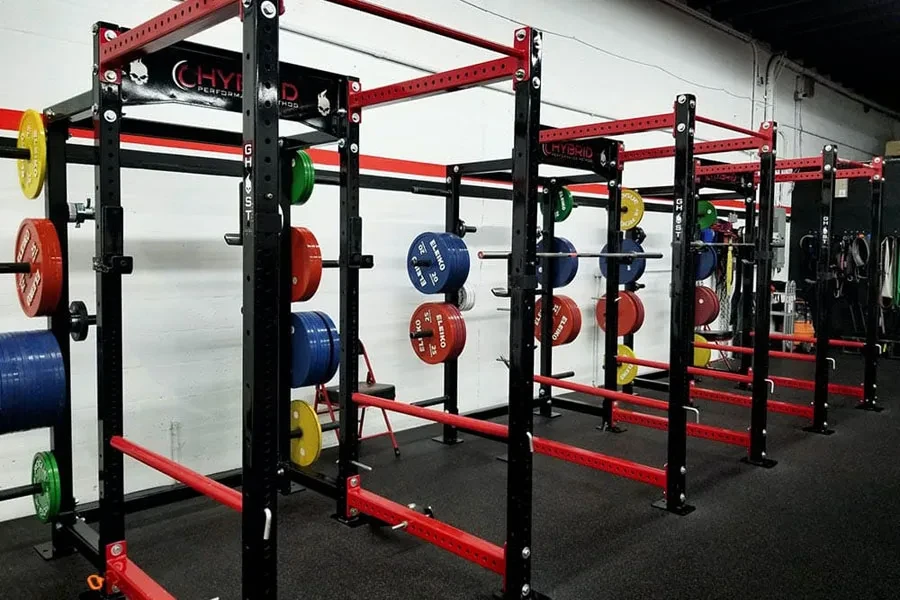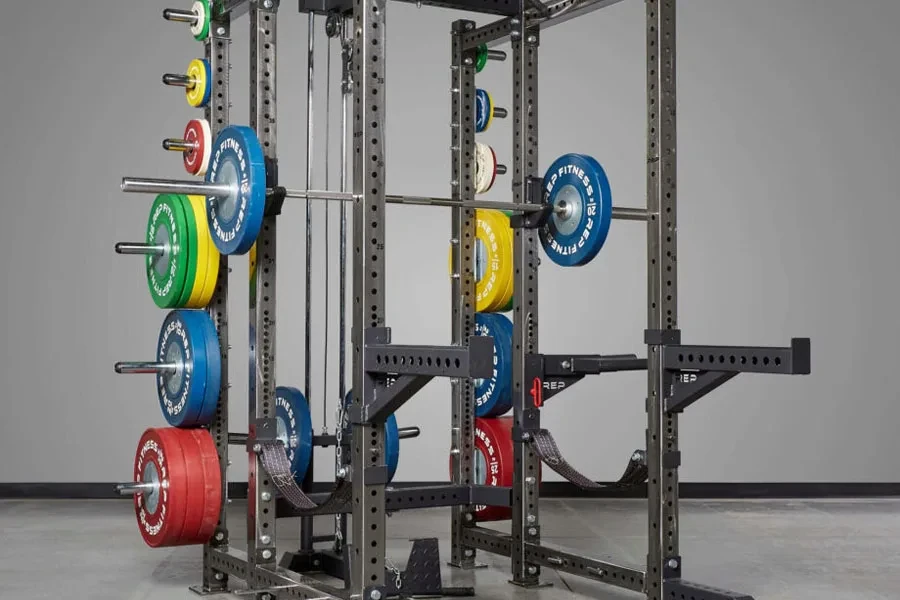Many consumers prefer using home gyms for the comfortable and private space that they provide in order to work out. But no home gym is complete without the holy grail of exercise equipment: power racks.
But knowing which power rack to stock in 2024 is becoming an increasingly difficult decision with the vast array of options on the market. In this article, we’ll provide tips on how sellers can best choose power racks based on the top features available.
Table of Contents
Why power racks are growing in popularity in 2024
Top features to look for when choosing power racks
Conclusion
Why power racks are growing in popularity in 2024
Home gyms are becoming increasingly popular, and so too are power racks, with research showing that this global market segment was valued at USD 0.71 billion in 2023. It is anticipated that the industry will grow to 0.92 billion by 2030 at a 6.1% CAGR.
As more people understand the benefits of strength training to overall health, more consumers are opting to own a power rack as a more convenient alternative to heading to a gym. In response to this shift, manufacturers are increasingly making power racks with home use in mind, helping to propel the market’s growth. Technological innovations are further stimulating growth, with smart power racks taking the industry to new heights.
Top features to look out for when choosing power racks
Rack height

Height, preferred exercises, and available space are the likely to be the main factors that consumers consider when choosing a suitable power rack. Regarding height, shorter racks may make it tricky to do exercises like pull-ups, while taller ones may require a step up to reach – finding the right balance for your target audience is the key.
Ideally, a rack should have enough vertical space so that users can perform exercises without restrictions while being short enough to allow enough clearance (preferably 6-12 feet) for chin-ups. Refer to the table below for a more thorough guide to rack height:
| Height | Suitable for | Notes |
| 72” | Users under 5’8” and with limited ceiling height | May limit the ability to do pull-ups without bending knees |
| 84” | 5’8” to 6’2” users in spaces with standard 8 to 9-foot ceilings | The most comfortable pull-up clearance for most users |
| 90” | 6’2” to 6’6” users or those wanting extra pull-up space | Provides a lot of clearance, even for taller users |
| 108” | Users over 6’6” and spaces with very high ceilings | This size maximizes vertical space but is less common |
Rack depth
Rack depth will determines how much space users will have to execute their lifts and move around, so it should be one of the top factors to consider. Deeper racks are the go-to for exercises like bench presses, squats, and overhead presses – such depths allow consumers to carry out these exercises without fear of knocking into the equipment. However, shallower racks may be more attractive to home gym enthusiasts with more limited space. Consult the table below for more information:
| Depth | Suitable for | Notes |
| 24” | Home gyms with limited space | Provides enough room for basic lifts but may feel cramped for certain movements |
| 30” | Average home gyms and most users | Offers a good balance of space internal space and overall footprint |
| 36” | Users desiring more space for diverse movements | Offers ample space for various barbell exercises and accessories |
| 42”+ | Commercial gyms and users with ample space | Better for complex movements and is big enough for attachments and storage, however, requires a large dedicated space |
Rack width

A user’s arm length will determine what rack width they require to exercise comfortably. Wider racks provide more room for lateral movements, while narrower varieties are better suited to limited floor spaces.
Nevertheless, rack width is not like the other parameters. Manufacturers often divide rack width into two categories:
| Width | Suitable for | Notes |
| 47” to 48” | Average home gyms and most users | Provides sufficient stability and space for basic barbell movements, and are generally more affordable |
| 49”+ | Users with wider builds or those who require extra room | Accommodates a wider stance or the use of accessories with the rack (like a bench). However, may be less suitable for tight spaces. |
Weight capacity
Sellers must offer power racks that correspond to the weight capacities that users require. Most people won’t need anything over 700 pounds, though others may opt for something larger.
| Weight capacity | Suitable for | Notes |
| 500 to 700 lbs | Beginners, light-to-moderate lifters, and most home gyms | Sufficient for most users, especially those focusing on basic strength training |
| 800 to 1,000 lbs | Intermediate-to-advanced lifters and those performing heavier lifts | Can handle increased weights for experienced lifters |
| 1,000+ lbs | Very strong lifters, powerlifters, and those looking for the highest safety margin | Necessary for extremely heavy lifting and provides maximum durability |
Tubing dimensions
Tubing size is another important aspect determining the kind of power rack a consumer will prefer. Smaller tubing (like 2.3” x 2.3”) is less expensive and may be all consumers ever need. However, the industry standard 3” x 3” is more stable, can better handle repeated use, and is the most commonly found size, meaning there is a large array of associated accessories. 3” x 3” tubing is also modular, allowing consumers to build out from them in any direction.
Tubing hole size and spacing
Tube hole size and spacing are important enough to affect the consumer’s long-term power rack training experience, so sellers must also weigh these aspects up before sourcing. Offering the best hole size allows more compatibility with accessories, giving consumers more options for add-ons like J-cups and spotter arms. The two types of tubing hole sizes are as follows:
| Tube hole size | Notes |
| ⅝” | The most common hole size, it offers excellent compatibility with accessories while providing sufficient strength for most users |
| 1” | Less common than ⅝”, racks may require adapters for some ⅝”-based attachments, making it less versatile |
Similarly, hole spacing determines how easy it will be to adjust these accessories on the rack. This comes in handy when users need to perform multiple exercises requiring different heights or are working out with other people. See the table below for more details on tube spacing:
| Hole spacing | Notes |
| 1” | Racks with this hole spacing offer the finest adjustments for J-hooks and safeties. They are also ideal for precise positioning, especially bench presses and squats. |
| 2” | This option is the most common spacing, providing good adjustability while maintaining rack strength |
| 3”+ | Anything above 3” is possible but less common. Although they are mostly seen in very budget-friendly racks, they still offer basic adjustments. |
| Westside hole spacing | This option combines 1” spacing in the bench/squat zone and 2” above and below. This unique tube spacing provides precise adjustments where needed and larger spacing for other uses. |
Conclusion
The power rack world has in recent years evolved from single racks with unmoving pieces to more modular, interchangeable pieces of equipment. Consumers can now easily expand and customize their racks, making each purchase capable of catering to their changing needs. Whether consumers want portable squat stands or a more imposing six-post power rack, there’s a multitude of options available.
To source the right racks for your consumers, keep up with market trends and focus on the top features discussed here. Finally, for more information about what other top sports products to sell, subscribe to Chovm.com Reads.





 বাংলা
বাংলা Nederlands
Nederlands English
English Français
Français Deutsch
Deutsch हिन्दी
हिन्दी Bahasa Indonesia
Bahasa Indonesia Italiano
Italiano 日本語
日本語 한국어
한국어 Bahasa Melayu
Bahasa Melayu മലയാളം
മലയാളം پښتو
پښتو فارسی
فارسی Polski
Polski Português
Português Русский
Русский Español
Español Kiswahili
Kiswahili ไทย
ไทย Türkçe
Türkçe اردو
اردو Tiếng Việt
Tiếng Việt isiXhosa
isiXhosa Zulu
Zulu